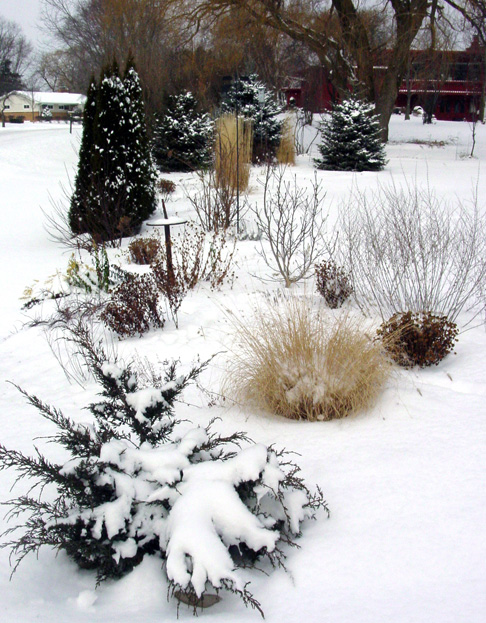I like my winter garden because it is a time for rest, reflection and planning for the new year. When we get snow, I spend a lot of time looking out the window admiring all the shrubs and fir trees covered in white looking so peaceful and serene. I usually leave that snow on my shrubs because it provides a layer of insulation and only if the snow is really heavy do I interfere and give the branches a gentle shake to get at least some of the snow to fall off. Snow is a big part of our winter weather in Wisconsin and is very helpful in the garden.
Why is snow good for the garden?
In Wisconsin, most of our perennials and trees go into dormancy in late fall. They are basically sleeping as a way to cope with the freezing temperatures and lack of water. Those perennials die back to the ground in fall and the deciduous trees lose their leaves. However those plants are still alive and simply waiting for better weather. Roots can still grow during dormancy and function while the ground is not frozen, taking up water as long as it is available. However during winter, cycles of freezing and thawing can damage vulnerable roots.
Evergreens are different because they continue to engage in photosynthesis and respiration. They lose water through their needles and can become dry. This makes them vulnerable to winter kill if they cannot take up water to replace what has been lost.
Snow provides moisture
Snow provides water. As long as the roots of a tree or shrub are still active, they need water. Evergreens especially need moisture in winter. Snow can help the trees replace this moisture. Compared to rain, snow melts slowly and soaks in gently so less water is lost to runoff.
Snow provides insulation
Snow also provides trees and plants with protective insulation. The snow serves as an insulating blanket to cover the ground and keep it from freezing. Also, when the moisture from the snow soaks into the ground, the moist soil holds heat more efficiently than dry soil and retards frost penetration, thus helping to protect roots. Especially with evergreens, snow cover is the best winter protection the trees can have.
What if it doesn’t snow?
For insulation, mulch makes the best alternative to a good snow cover. In the case of a dry winter, the mulch will help retain moisture. Spread the mulch over the root zone, if possible out to the drip line, where it will do the most good and be careful not to pile the mulch too close to the tree’s trunk because it can attract rodents. Then, when snow does fall, it simply adds more insulation and will help protect your plants until spring.





And it just looks so pretty!
A very good description of winter in the garden. Love your pictures.